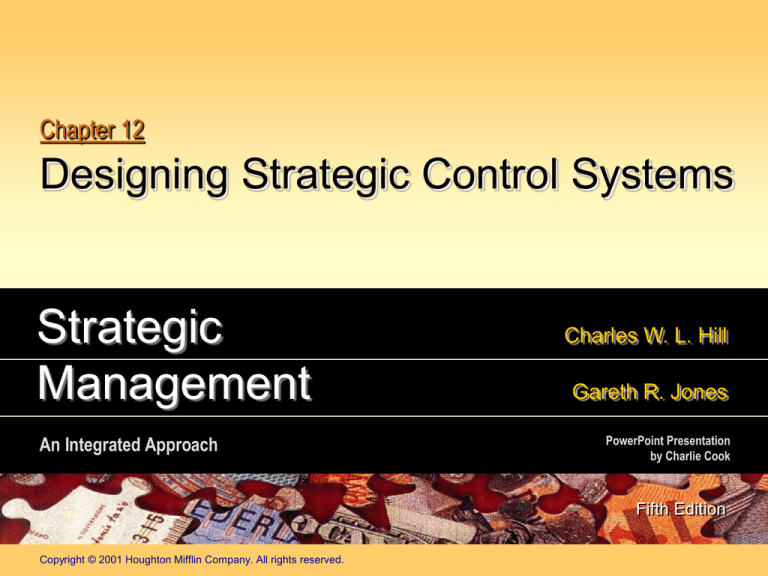
Chapter 12
Designing Strategic Control Systems
Strategic
Management
An Integrated Approach
Charles W. L. Hill
Gareth R. Jones
PowerPoint Presentation
by Charlie Cook
Fifth Edition
Copyright © 2001 Houghton Mifflin Company. All rights reserved.
What Is Strategic Control ?
Strategic control
The selection of an organizational strategy and
matching structure for the organization.
Creation of control systems to monitor and evaluate
strategic performance of the organization.
The importance of strategic control
Achieving operational efficiency
Maintaining focus on quality
Fostering innovation
Insuring responsiveness to customers
Copyright © 2001 Houghton Mifflin Company. All rights reserved.
12-2
A Balanced Scorecard Approach
FIGURE 12.1
Copyright © 2001 Houghton Mifflin Company. All rights reserved.
12-3
Strategic Control Systems
Steps in designing an
effective control
system
FIGURE 12.2
Copyright © 2001 Houghton Mifflin Company. All rights reserved.
12-4
Strategic Control Systems
Levels of organizational
control
FIGURE 12.3
Copyright © 2001 Houghton Mifflin Company. All rights reserved.
12-5
Strategic Control Systems
Types of control systems
Financial
Controls
Output
Controls
Behavior
Controls
Organizational
Culture
Stock price
Divisional goals
Budgets
Values
ROI
Functional goals
Standardization
Norms
Individual goals
Rules and
procedures
Socialization
TABLE 12.1
Copyright © 2001 Houghton Mifflin Company. All rights reserved.
12-6
Management by Objectives (MBO)
1. Establish specific goals
and objectives at each
level in the organization.
2. Make goal setting a
participatory process.
3. Conduct a periodic review of progress
toward meeting goals.
Copyright © 2001 Houghton Mifflin Company. All rights reserved.
12-7
Behavior Controls
Operating Budgets
A blueprint for the use of organizational resources.
Standardization
Standardization of inputs
Standardization of conversion activities
Standardization of outputs
Rules and procedures
Positive effect: Help control, guide, and limit behaviors.
Negative effect: Rules lead to bureaucratic behaviors.
Copyright © 2001 Houghton Mifflin Company. All rights reserved.
12-8
What Is Organizational Culture?
Culture
The collection of values and norms shared by people and
groups in an organization.
Shared values and a common culture increase integration
and improve coordination.
Values
Beliefs and ideas about common goals and proper behaviors.
Norms
Act as guidelines or expectations that prescribe acceptable
behavior by organizational members.
Copyright © 2001 Houghton Mifflin Company. All rights reserved.
12-9
Organizational Culture
Ways of transmitting organizational culture:
FIGURE 12.4
Copyright © 2001 Houghton Mifflin Company. All rights reserved.
12-10
Culture and Strategic Leadership
The influence of the founder
Initial cultural values and management
style is imprinted on the organization
by its founder.
Organizational structure
Structure follows strategy.
Strategic leadership affects
the cultural norms and values
that develop in the organization.
Copyright © 2001 Houghton Mifflin Company. All rights reserved.
12-11
Adaptive and Inert Cultures
Adaptive cultures
Are innovative and encourage and
reward initiative by middle and
lower-level managers.
Inert cultures
Are cautious and conservative;
do not value and may discourage
by initiative by middle and lower-level managers.
Copyright © 2001 Houghton Mifflin Company. All rights reserved.
12-12
The Composition of the Top-Management
Team
Top management
Determines the strategic direction of the company.
Establishes organizational values and norms.
Diversity in top management
Reduces the threat of organizational inertia.
Improves decision making.
Helps the culture become adaptive.
Guards against inbreeding and homogeneity.
Copyright © 2001 Houghton Mifflin Company. All rights reserved.
12-13
Traits of Strong and Adaptive Cultures
A bias for action
Have values that promote
autonomy and entrepreneurship.
Nature of the
organization’s mission
“Sticks to its knitting”
How to operate the organization
Create an organizational
design that motivates
employees to do their best.
Copyright © 2001 Houghton Mifflin Company. All rights reserved.
12-14
Strategic Reward Systems
Individual reward systems
Piecework plans
Commission systems
Bonus plans
Promotion
Group and organizational
reward systems
Group-based bonus systems
Profit sharing systems
Employee stock option systems
Organization bonus systems
Copyright © 2001 Houghton Mifflin Company. All rights reserved.
12-15

